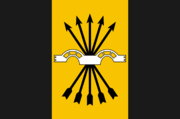Catholic Royalist Party
Catholic Royalist Party Partido Real Católico | |
|---|---|
 | |
| Abbreviation | PRC |
| Caudillo | Antonio Sáenz Heredia |
| Founder | Francisco Dueñas Díaz |
| Founded | 3 December 1887 |
| Legalized | 10 December 1887 |
| Dissolved | 4 October 1949 |
| Split from | National Conservative Party |
| Merged into | Creeperian Initiative |
| Headquarters | San Salvador, Creeperopolis |
| Newspaper | El Gran Católico |
| Student wing | Frente de Juventudes |
| Youth wing | Juventudes Católicos |
| Women's wing | Sección Femenina |
| Paramilitary wing | Falange Creeperiano |
| Membership (1930) | 2,900,000 (party claim) |
| Ideology | Sáenzism–Falangism
|
| Political position | Right-wing to far-right |
| Religion | Creeperian Catholicism |
| National affiliation | Creeperian Conservative Coalition |
| Colors | Red, black, gold |
| Slogan | ¡Presente por la'Patria!" |
| Anthem | Cara'l Sol |
| Parliament (1932) | 25 / 100
|
| Party flag from 1902. | |
 | |
The Catholic Royalist Party (Creeperian Spanish: Partido Real Católico; abbreviated PRC), also contemporarily referred to as the Sáenist Faction (Creeperian Spanish: Facción Sáenista) and The Fascists (Creeperian Spanish: Los'Fascistas)[note 1] by leftists, was a right-wing to far-right political party which was active from 1887 to 1949 during the Second Parliamentary Era of Creeperopolis.
The party split from the National Conservative Party (PCN) shortly after the its establishment due to disagreements over certain political agendas. It was founded by Francisco Dueñas Díaz, a former military commander during the Adolfisto. After his resignation as party leader in 1901, he was succeeded by Antonio Sáenz Heredia, who assumed total control of the party by 1902. With Sáenz Heredia as the party's Caudillo, the party shifted further to the right and adopted several new extreme-right ideologies. Additionally, the party established a paramilitary wing, the Falange Creeperiano, and began to adopt dictatorial ambitions, with the end goal of abolishing democracy in Creeperopolis and ruling the country with the Emperor as a figurehead. Despite various attempts to do so, political and civilian opposition prevented the party from completely taking control of the government, however, the party did wield significant power, with Sáenz Heredia holding the position of prime minister on four different occasions.
National Catholicism and monarchism were the party's primary ideologies, with other core ideologies being nationalism, social conservatism, and anti-secularism. From 1902, the party also adopted anti-atheism, anti-Islamism, anti-Protestantism, anti-communism, and in 1933, Romerism. The ideologies of the party have broadly been combined by political scientists as Sáenzism–Falangism.
During the Creeperian Civil War, the party supported the far-right Catholic Imperial Restoration Council (CRIC), being one of the faction's most important supporters. The Imperial Council eventually won the civil war, defeating the far-left National Council for Peace and Order (CNPO) in the Battle of the Zapatista River on 30 September 1949. On 4 October 1949, the party was abolished and merged into the Nationalist Creeperian Catholic Royal Initiative and the Pro-Fatherland Front of Unification (IRCCN y la'FPPU; Creeperian Initiative), together with the National Conservative Party and the Creeperian Pro-Fatherland Front. Sáenz Heredia was appointed as the new party's secretary and held the position until his death in 1957.
The Catholic Royalist Party is considered to be one of the most important political entities of the Second Parliamentary Era. Of the parties that merged to form the Creeperian Initiative, the structure and ideals of the Catholic Royalist Party were, and remain, the most pronounced, as the party currently is very National Catholic, monarchist, nationalist, anti-communist, and Romerist. Additionally, the party's symbol, the yugo y flechas (yoke and arrows), was added onto the flag of Creeperopolis in 1933 by the Imperial Council, and it currently remains on the national flag, solidifying the party's influence on modern Creeperopolis.
Contents
- 1 Names
- 2 History
- 2.1 Establishment: 1887–1892
- 2.2 Junior member of a coalition government: 1892–1901
- 2.3 Rise of Sáenz Heredia: 1901–1902
- 2.4 Sáenz Heredia's first term: 1902–1907
- 2.5 Inter-term: 1907–1912
- 2.6 Election of 1912 and Sáenz Heredia's second term: 1912–1917
- 2.7 Inter-term: 1917–1922
- 2.8 Sáenz Heredia's third term: 1922–1927
- 2.9 Crisis of 1928 and Sáenz Heredia's fourth term: 1927–1928
- 2.10 Final years of democracy: 1928–1933
- 2.11 Civil war and merge into the Initiative: 1933–1949
- 3 Party ideologies
- 4 Party composition
- 5 Membership
- 6 Legacy
- 7 Party symbology
- 8 Electoral results
- 9 See also
- 10 Notes
- 11 External links
Names
The party was founded as the Catholic Royalist Party (Partido Real Católico; PRC) and it retained the same name throughout its entire existence, although, there were some proposals by some high-ranking party members to change the party's name to the Catholic Romerist Party (Partido Romeristo Católico; PRC) during the late-1940s.
Several leftists and leftists organizations had various pejorative nicknames for the Catholic Royalist Party. The most commonly used nickname was the Sáenist Faction (Facción Sáenista), or sometimes the Sáenist Band (Banda Sáenista). The party was also referred to as The Fascists (Las'Fascistas), however, the name was used less frequently towards the end of the Second Parliamentary Era as it had begun to be applied more in reference to the Creeperian Pro-Fatherland Front (FPPC). Some moderate-rightist politicians referred to the party as the Absolutists (Absolutos) and the Fundamentalists (Fundamentalistas).
History
Establishment: 1887–1892
| Part of a series on |
| Romerism |
|---|
 |
| Categories: |
Junior member of a coalition government: 1892–1901
Rise of Sáenz Heredia: 1901–1902
Sáenz Heredia's first term: 1902–1907
Inter-term: 1907–1912
Election of 1912 and Sáenz Heredia's second term: 1912–1917
Inter-term: 1917–1922
Sáenz Heredia's third term: 1922–1927
Crisis of 1928 and Sáenz Heredia's fourth term: 1927–1928
Final years of democracy: 1928–1933
Civil war and merge into the Initiative: 1933–1949
Party ideologies
Party composition
Command structure
Primary party leader
| No. | Leader | Term | ||
|---|---|---|---|---|
| Term started | Term ended | |||
| Chairman of the Catholic Royalist Party | ||||
| 1. | 
|
Francisco Dueñas Díaz (1840–1905) |
3 December 1887 | 13 December 1901 |
| 14 years and 10 days | ||||
| 2. | 
|
Antonio Sáenz Heredia (1871–1957) |
13 December 1901 | 17 February 1902 |
| 66 days | ||||
| Caudillo of the Catholic Royalist Party | ||||
| 2. | 
|
Antonio Sáenz Heredia (1871–1957) |
17 February 1902 | 4 October 1949 |
| 47 years and 229 days | ||||
Party wings
Frente de Juventudes student wing
Juventudes Católicos youth wing
Sección Femenina women's wing
Falange Creeperiano paramilitary wing
Membership
Membership count
Primary demographics
Party ranks
Legacy
Party symbology
Symbols
Slogans
Party anthem: Cara'l Sol
| Creeperian Spanish | Translation |
|---|---|
|
|
Electoral results
Parliament
| Election | Votes | % | Position | Seats | +/– | Status in legislature | Leader | Notes |
|---|---|---|---|---|---|---|---|---|
| 1887 | 399,319 | 14.41% | 10 / 100
|
New | Opposition | Francisco Dueñas Díaz | ||
| 1892 | 520,832 | 15.76% | 11 / 100
|
Junior party in coalition | Coalition with PCN | |||
| 1897 | 1,113,760 | 33.21% | 33 / 100
|
Junior party in coalition | Coalition with PCN | |||
| 1902 | 1,677,072 | 44.83% | 46 / 100
|
Senior party in coalition | Antonio Sáenz Heredia | Coalition with PCN | ||
| 1907 | 847,654 | 23.48% | 23 / 100
|
Opposition | ||||
| 1912 | 1,166,073 | 36.59% | 41 / 100
|
Senior party in coalition | Coalition with PCN Election widely believed to be fraudulent | |||
| 1917 | 1,107,368 | 28.17% | 29 / 100
|
Opposition | ||||
| 1922 | 1,330,025 | 35.16% | 36 / 100
|
Senior party in coalition | Coalition with PCN | |||
| 1927 | 1,721,673 | 30.18% | 30 / 100
|
Opposition | ||||
| 1932 | 1,035,759 | 26.02% | 25 / 100
|
Junior party in coalition | Coalition with PCN and FPPC |
Departmental Captain Generals
See also
- Castillianan Coalition of Autonomous Rights, a similar party in Castilliano
Notes
- ↑ The name "The Fascists" was initially applied by leftists to the Catholic Royalist Party, but with the establishment of the Creeperian Pro-Fatherland Front (FPPC) in 1921, the name began to be more frequently used in reference to the FPPC, however, the name was still applied to the PRC, but to a lesser degree.
External links
- Catholic Royalist Party (IIWiki; 29 February 2020)
- Articles with short description
- Use dmy dates from January 2022
- Use Jackian from January 2022
- All LCNWiki articles written in Jackian
- Creeperopolis
- Creeperopolis RP
- Creeperopolis Terraconserva
- Terraconserva
- Political Party
- Creeperian Civil War
- Creeperian Conflicts
- Romerism
- Romero I of Creeperopolis
- Antonio Sáenz Heredia
